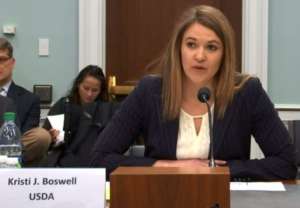

The Agriculture Department said it plans to make a final recommendation on a new location for both the Economic Research Service and the National Institute of F...
Best listening experience is on Chrome, Firefox or Safari. Subscribe to Federal Drive’s daily audio interviews on Apple Podcasts or PodcastOne.
The Agriculture Department is moving full steam ahead to relocate two of its bureaus outside of the Washington, D.C., metropolitan area, even though the agency won’t release a cost-benefit analysis for the move until it chooses a final site.
But Kristi Boswell, a senior adviser to USDA Secretary Sonny Perdue, told Congress on Wednesday the agency was moving quickly to finalize a new location for two of its bureaus to “limit this limbo period of uncertainty” for the agency’s employees.

More than 130 sites from 35 states expressed initial interest in hosting a new space for the Economic Research Service (ERS) and National Institute of Food and Agriculture (NIFA) after USDA first announced its plans last August to move the two bureaus out of the D.C. area.
The department has further whittled down those areas of interest to 68. Boswell said the department would release a shorter list of possible locations in the coming days.
USDA plans to make a final site recommendation to the secretary by early May, she said. Only then will the agency provide a cost-benefit analysis for the relocation of ERS and NIFA for whatever final site they choose.
“We are confident that the completed analysis will show we can be more efficient with our dollars and be in a community that provides for a high quality of life for our employees,” Boswell said Wednesday during a hearing on USDA’s relocation proposal before the House Appropriations Agriculture, Rural Development and Food and Drug Administration Subcommittee.
Not all of the nearly 600 ERS and NIFA employees will move to the new location. Boswell said 76 ERS employees and 20 NIFA employees will remain in D.C., slightly more than what the agency predicted when it discussed the moves with employees back in August.
That leaves 253 ERS and 315 NIFA employees who would be asked to move to a new location.
“Each of those permanent employees will have the opportunity to relocate and remain in their position at a new location, and we hope that many do,” Boswell said. “However, we know that this process is hard. We know that we are affecting real lives and real families, and that is not something that we take lightly.”
USDA has met with stakeholders, answered questions about the move and held listening sessions with employees, Boswell said. Their feedback will be part of the final analysis that Ernst & Young, the contractor that USDA hired last year to help examine relocation proposals.
“Employee committees are reporting to their agency leadership, and then agency leadership is coordinating with mission-area leadership all the way through the deputy secretary and secretary’s office,” Boswell said. “That dialogue is consistently occurring. In fact, we’ve even designated a specific staff to do touch-points with our employees to make sure that their feedback is delivered to Ernst & Young in this process.”
The two bureaus are splitting the cost of the Ernst & Young contract, Boswell said, which totaled $340,000.
Attrition is a concern for USDA, Boswell said, but she didn’t give Congress a projection of how many employees the agency anticipated may leave.
Boswell said the relocation would not prompt reductions-in-force. But USDA’s 2020 budget request suggests personnel cuts. The agency estimated it had 329 employees within ERS and proposed 160 employees for 2020. It’s unclear, however, how exactly USDA plans to cut the ERS workforce in half — whether the agency it envisions it would lose 169 employees through the relocation or some other means.
Boswell said USDA’s efforts to include employees in the feedback process show USDA has been transparent about the relocation process from the beginning.
But members of the subcommittee, mostly Democrats, said the agency hasn’t been transparent about the move with them. Democrats on the committee sent a letter to USDA when it first announced tentative plans for the relocation last August. They received a two-page letter in return, according to Rep. Chellie Pingree (D-Maine).
“I don’t feel like it’s been a transparent process,” she said. “While I understand there’s some argument to be made that if people are going to have to go through this dramatic change, leaving them in limbo for a shorter period of time as possible is helpful. On the other hand, a move this dramatic with this many moving parts and this money associated with it requires more in-depth thinking. We should be much more engaged.”
Rep. Sanford (D-Ga.), the subcommittee chairman, said he was skeptical USDA had done a cost-benefit analysis before announcing its intent to relocate the two bureaus and expressed concern for the way the agency had rolled out the proposal to employees and other stakeholders.
Boswell, however, said the relocation would allow USDA to better attract and retain top talent to ERS and NIFA.
But former ERS administrators and chief scientists for USDA largely disputed the agency’s optimism.

 Exclusive
Exclusive Smith-Evans was one of four former ERS and USDA officials who appeared before the subcommittee. All of them opposed the proposed relocation.
“Anything can be made to work, but what’s missing is overwhelming evidence that it would work better than it works now,” John Lee, a former ERS administrator of 12 years.
Republicans were largely supportive of USDA’s proposed relocation, though subcommittee Ranking Member Jeff Fortenberry (R-Neb.) said he understood Democrats’ concerns about a lack of cost-benefit analysis or written justification.
“We are still waiting for some information and expect USDA to promptly deliver supporting documentation when it’s available,” he said.
Copyright © 2024 Federal News Network. All rights reserved. This website is not intended for users located within the European Economic Area.
Nicole Ogrysko is a reporter for Federal News Network focusing on the federal workforce and federal pay and benefits.
Follow @nogryskoWFED
